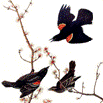Center, Internet, Wildlife Damage Management

Bird Control Seminars Proceedings
Document Type
Article
Date of this Version
September 1968
Abstract
The total scope of chemosterilants is very wide so I will comment only on the pigeon chemosterilant developed by G.D. Searle & Co. and then briefly on the role of chemosterilants, generally, in bird control. Searle's ORNITROL (SC-12937, azacosterol) is a chemosterilant which in-hibits reproduction in the pigeon and is to be used as a means of controlling pigeon populations. It is fed as a treated whole corn bait (0.1%) for a period of ten days and inhibits reproduction for about six months. We recommend treat-ment in the early spring just before the onset of the peak reproduction season to be followed, if necessary, by a second treatment later in the year. Azacosterol exerts its inhibitory effect through the blocking of the synthesis of cholesterol, thought to be a vital component in the formation of egg yolks. Interest initially arose in the possible use of cholesterol blockers to delay egg production in starter pullets several years ago. Among others tested was Searle's SC-11952. It was tested in hens, in 1961, at Iowa State University, to determine the effects on egg cholesterol levels and on egg production. This compound showed definite activity. Azacosterol is a more potent analog of SC-11952. Further work with SC-12937 in chickens proved the activity of this compound; and it attracted the attention of Dr. William H. Elder, Professor of Zoology, University of Missouri, who wanted to test the compound's activity in pigeons.

